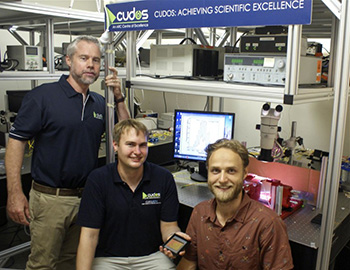
Benjamin Eggleton and researchers Thomas Büttner and Moritz Merklein from CUDOS at the University of Sydney, show their chalcogenide photonic chip. Credit: Univ. of Sydney
Recent research in on-chip nonlinear optics has identified ways to to exploit nonlinear optical interactions in materials with large nonlinearity via high-Q resonators and slow-light structures, but such techniques often limit efficiencies and cause signal distortion when applied in photonic integrated circuits. In a breakthrough study, researchers at the University of Sydney (New South Wales, Australia) demonstrated a powerful and flexible technique for enhancing and inhibiting nonlinear interactions on a chalcogenide chip that can extend to use in other materials and nonlinear processes (Nat. Comm., doi: 10.1038/ncomms7396).
Professor of physics Ben Eggleton and colleagues from the Centre for Ultrahigh bandwidth Devices for Optical Systems (CUDOS) at the University of Sydney enhanced a chalcogenide chip with a narrow-band Bragg grating to achieve stimulated Brillouin scattering at power levels two times greater than the threshold.
The team scribed the one-dimensional Bragg grating into the chalcogenide (As2S3) chip to create a highly nonlinear waveguide with tailored density of states. They then used a single-frequency laser to pump a signal into the waveguide, the frequency of which is tunable to the slow-light region at the edge of the photonic band gap. The tuning of the pump laser in and out of the band edge enables changing of the nonlinear interaction strength, which can enhance or suppress stimulated Brillouin scattering.
Stimulated Brillouin scattering occurs when two optical waves interact with an acoustic wave to produce a backwards-scattering wave called a Stokes wave. Typically, this nonlinear scattering is undesirable because it distorts the signal in fiber or in on-chip applications. But harnessing the optical nonlinearity via tuning it on and off on-demand could make it useful in applications including microwave and all-optical signal processing schemes. (Read more about CUDOS' work on stimulated Brillouin scattering in OPN's February feature article "Harnessing On-Chip SBS.")
In the CUDOS scheme, when the Stokes wave is enhanced, a 15-line Brillouin frequency comb is generated. When the Stokes wave is inhibited, the pump power is not depleted, solving a significant challenge in on-chip efficiency.
Lead author and Ph.D. candidate Moritz Merklein with CUDOS commented, “We think this approach can be generalized to many other optical nonlinearities.”

